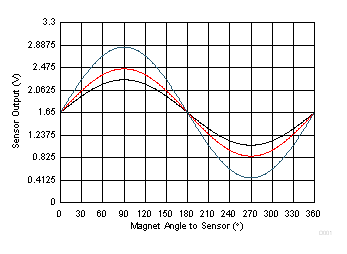SLYA036B July 2018 – November 2021 DRV5053 , DRV5053-Q1 , DRV5055 , DRV5055-Q1 , DRV5056 , DRV5056-Q1 , DRV5057 , DRV5057-Q1
- Trademarks
- 1Introduction
- 2Overview
- 3Device Descriptions
-
4Methods
- 4.1 Uncalibrated Implementations
- 4.2 Peak Calibrated Implementations
- 4.3 Lookup Table Calibration Implementations
- 4.4 Peak Calibrated Plus Lookup Table Hybrid
- 5References
- 6Revision History
4.1.2.1 Specific Implementation
With one sensor, as shown in Figure 4-2, the sensor output voltage takes the form shown in Figure 4-3. Because there is no calibration phase, the peak amplitude is unknown.
 Figure 4-2 One Sensor Near Magnet
Figure 4-2 One Sensor Near Magnet Figure 4-3 One Sensor Uncalibrated Data
Figure 4-3 One Sensor Uncalibrated Data